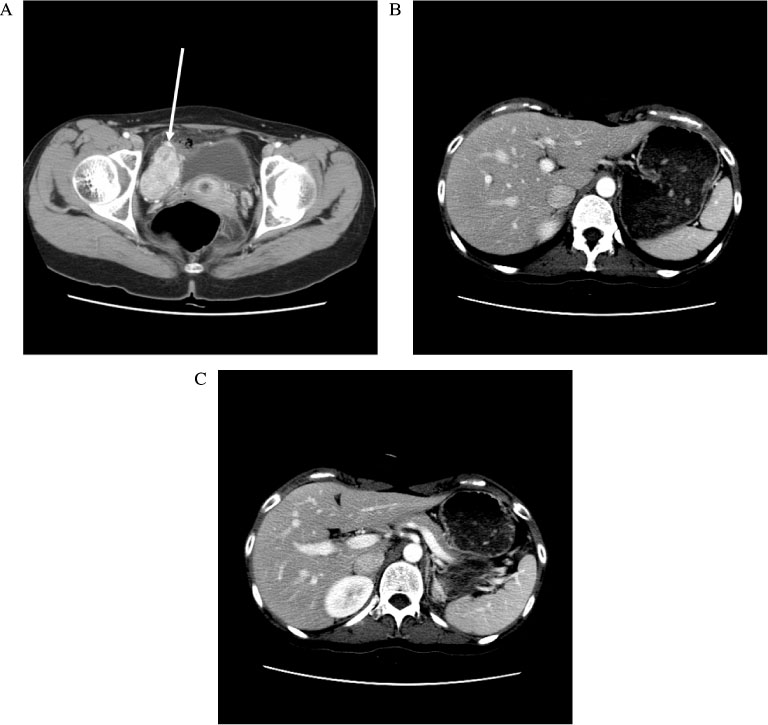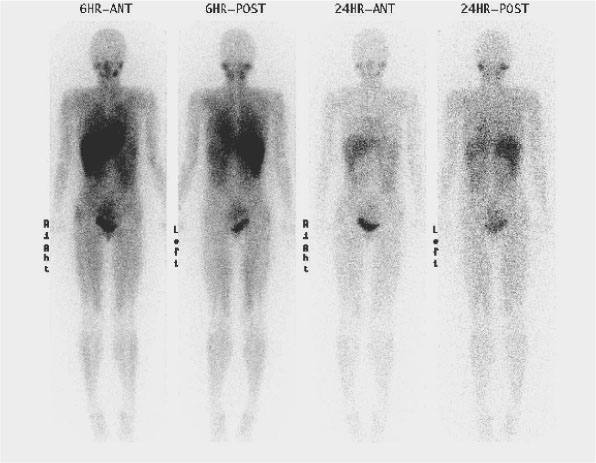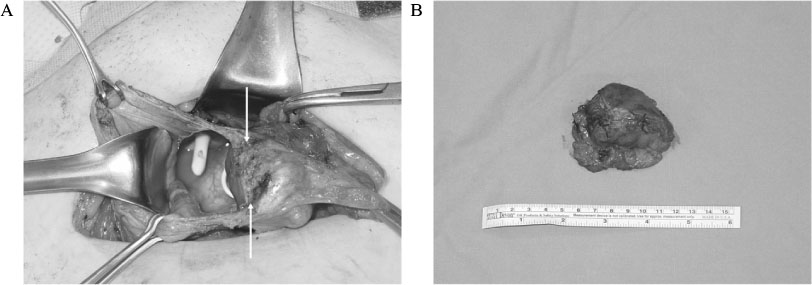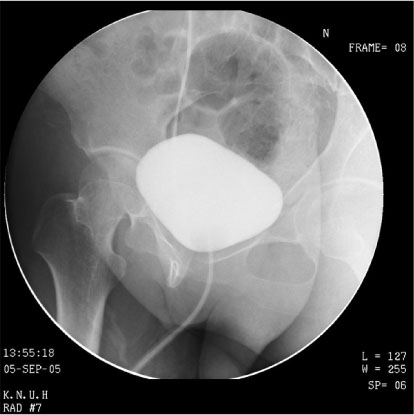J Korean Endocr Soc.
2006 Oct;21(5):402-407. 10.3803/jkes.2006.21.5.402.
Urinary Bladder Pheochromocytoma with a Long Asymptomatic Period
- Affiliations
-
- 1Department of Internal Medicine, Kyungpook National University School of Medicine, Korea.
- KMID: 1511990
- DOI: http://doi.org/10.3803/jkes.2006.21.5.402
Abstract
- Pheochromocytoma arises from chromaffin cells of the paraganglionic system. Urinary bladder pheochromocytoma is very rare tumor that accounts for less than 0.06% of all urinary bladder tumors and it is less than 1% of all pheochromocytoma. Urinary bladder pheochromocytoma usually arises from the sympathetic nervous system of the bladder wall. Paroxysmal headache and palpitation precipitated by micturition are common specific symptoms of this tumor. The paroxysm commonly persists or the patients relapse in a few days or months. Herein, we report a case of urinary bladder pheochromocytoma with a long asymptomatic period.
Keyword
MeSH Terms
Figure
Reference
-
1. Landsberg L, Young JB. Wilson JD, Foster DW, editors. Catecholamine and adrenal medulla. Williams Textbook of endocrinology. 1992. 8th Ed. Philadelphia, W.B.: Saunders Company;627–705.2. Gifford RW, Manger WM, Bravo EL. Pheochromocytoma. Endocrinol Metab Clin North Am. 1994. 23:387–404.3. Gyftopoulos K, Perimenis P, Ravazoula P, Athanassopoulos A, Barbalias GA. Pheochromocytoma of the urinary bladder presenting only with macroscopic hematuria. Urol Int. 2000. 65:173–175.4. Bourne RB, Beltoos E. Pheochromocytoma of the bladder: Case report and summary of literature. J Urol. 1967. 98:361–364.5. Fraley SE, Smith CL. Unusual location of pheochromocytoma of the bladder. J Urol. 1959. 81:130–132.6. Cheng L, Leibovich BC, Cheville JC, Ramnani DM, Sebo TJ, Neumann RM, Nascimento AG, Zincke H, Bostwick DG. Paraganglioma of the urinary bladder: can biologic potential be predicted? . Cancer. 2000. 88:844 –852.7. Melicow MM. One hundred cases of pheochromocytoma at the Columbia Presbyterian Medical center, 1926-76: a clinicopathological analysis. Cancer. 1977. 40:1987–2004.8. Shin DH, Kim SG, Kim DR, Kim NH, Choi KM, Baik SY, Choi DS. Clinical study of the pheochromocytoma. J Kor Soc Endocrinol. 2002. 17:554 –563.9. Baima C, Casetta G, Vella R, Tizzani A. Bladder pheochromocytoma: a A 3-year follow-up after transurethral resection (TURB). Urol Int. 2000. 65:176–178.10. Chung YS, Park SW, Ahn KJ, Lee EJ, Kim SK, Kim KR, Lee HC. A case of pheochromocytoma of the urinary bladder. J Kor Soc Endocrinol. 1991. 6:280–281.11. Sung GT, Lee SK, Yoon JB. Pheochromocytoma of the urinary bladder-Report of a case and literature review. Kor J Urol. 1991. 32:829–835.12. Ahn TY, Chung SK, Han YT, Lee MC. A case of pheochromocytoma of the bladder. Kor J Urol. 1988. 29:856–860.13. Pacak K, Linehan WM, Eisenhofer G, Walther MM, Goldstein DS. Recent advances in genetics, diagnosis, localization, and treatment of pheochromocytoma. Ann Intern Med. 2001. 134:315–329.14. Moulton JS. CT of the adrenal glands. Sem Roentgen. 1988. 23:288–303.15. Shapiro B, Copp JE, Sisson JC, Eyre PL, Wallis J, Beierwaltes WH. Iodine-131 metaiodobenzylguanidine for the locating of suspected pheochromocytoma: experience in 400 cases. J Nucl Med. 1985. 26:576–585.16. Chatal JF, Charbonnel B. Comparison of iodobenzylguanidine imaging with computed tomography in locating pheochromocytoma. J Clin Endocrinol Metab. 1985. 61:769–772.17. Nakatani T, Hayama T, Uchida J, Nakamura K, Takemoto Y, Sugimura K. Diagnostic localization of extra-adrenal pheochromocytoma: comparison of 123I-MIBG imaging and 131I-MIBG imaging. Oncol Rep. 2002. 9:1225–1227.18. Onishi T, Sakata Y, Yonemura S, Sugimura Y. Pheochromocytoma of the urinary bladder without typical symptoms. Int J Urol. 2003. 10:398–400.19. Nesi G, Vezzosi V, Amorosi A, Menghetti I, Selli C. Paraganglioma of the urinary bladder. Urol Int. 1996. 56:250–253.






